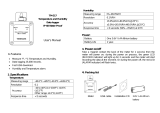
4 GMC-I Messtechnik GmbH
Contents Page Contents Page
1 Applications ..................................................................................6
2 Safety Features and Precautions ..................................................7
3 Initial Start-Up ..............................................................................8
3.1 Installing or Replacing Batteries .......................................................8
3.2 Selecting a Language, Basic Function and Sub-Function Settings ......8
3.3 Battery Test ....................................................................................9
3.4 Recharging the rechargeable Batteries ...........................................10
4 Abbreviated Instructions for Quick Initial Start-Up .....................12
5 General Instructions ...................................................................14
5.1 Connecting the Instrument .............................................................14
5.2 Automatic Settings, Monitoring and Shut-Off ..................................14
5.3 Measurement Value Display ...........................................................15
5.4 Testing Earthing Contact Sockets for Correct Connection .................15
5.5 Help Function ...............................................................................16
6 Measuring Alternating Voltage and Frequency ...........................16
6.1 Voltage between L and N (U
L-N
) .....................................................16
6.2 Voltage between L and PE, N and PE, as well as L and N ................17
6.3 Voltage between the Probe and PE (U
S-PE
) ......................................18
6.4 Measuring Current with a Clip-On Current Transformer ...................18
7 Testing RCDs ..............................................................................20
7.1 Measuring Contact Voltage (with reference to nominal residual current)
with
1
/
3
Nominal Residual Current and Tripping Test with Nominal Re-
sidual Current ...............................................................................20
7.2 Special Testing for Systems and RCCBs .........................................23
7.2.1 Testing for Systems and RCCBs with Rising Residual Current ..........23
7.2.2 Testing of RCCBs which are Suited for
Pulsating DC Residual Current .......................................................24
7.3 Testing for Special RCDs ...............................................................25
7.3.1 Systems with Selective RCDs .........................................................25
7.3.2 Type G RCCBs ..............................................................................27
7.4 Testing with Adjustable Residual Current ........................................28
7.5 Testing RCDs in IT Systems ...........................................................28
7.6 Testing Residual Current Circuit Breakers in TN-S Systems .............30
8
Testing of Breaking Requirements for Overcurrent Protective Devices,
Measurement of Loop Impedance and Determination of Short-
Circuit Current (functions Z
Loop
and I
K
) ......................................31
8.1 Measurement with Positive or Negative Half-Waves ........................32
8.2 Evaluation of Measurement Values .................................................33
8.3 Loop Impedance Measurement
– Measurement via and without tripping the RCCB .........................33
8.4 Testing Meter Start-Up with the Adapter .........................................34
9 Measuring Supply Impedance (function Z
I
) ................................35
9.1 Testing Meter Start-Up with Earthing Contact Adapter .....................36
10 Earthing Resistance Measurement (function R
E
) .......................37
10.1 Measuring with Probe ...................................................................38
10.2 Measuring without Probe ...............................................................38
10.3 Evaluation of Measurement Values .................................................39
11 Measuring Insulation Resistance
(Function R
ISO
) ............................................................................40
11.1 Insulation Measurement with Rising Test Voltage ............................41
11.2 Evaluation of Measurement Values .................................................42
11.3 Setting the Limit Value ..................................................................42





















